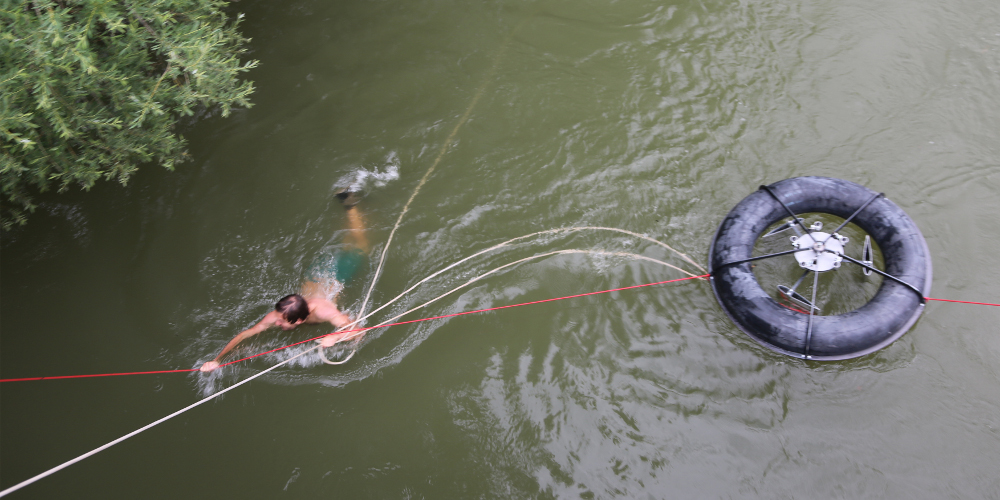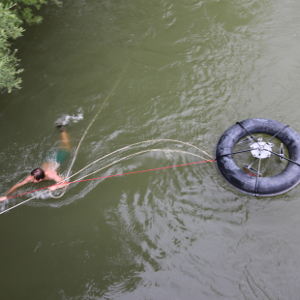
As reported will ITU Telecom World 2014 and Ars Electronica be on hand to spotlight work being done by some of the trailblazing thinkers of our time. “The Lab” is a presentation that shows what creative innovation and thinking in terms of alternatives can mean. 16 selected projects demonstrate the essential role that telecommunications above all will play in the future.
One of these creative, future-oriented projects is Rotor, a moderately priced, small, mobile power plant that delivers a “plug-and-play,” instant solution to the problem of providing electricity to regions beyond the grid. It’s designed especially for communities, farmers and NGOs in rural areas that lack access to power but are located near a river. For them, Rotor offers an economical alternative for generating electrical current. This product provides energy from a renewable source, energy that’s a prerequisite for socioeconomic development, sustainable growth, the proliferation of the telecommunications system, and for delivering basic social services and health care.
In this interview, Markus Heinsdorff and Andreas Zeiselmair told us about Markus’ sojourn in the Ecuadorian rainforest, where he came up with the idea of generating energy from water in remote areas that have no access to the electric grid, and how these two plan to implement the idea despite the fact that the region lacks the necessary financial resources, technical knowhow and the infrastructure to transport bulky, elaborate equipment.
How did you come upon the idea that led to Rotor?
Markus Heinsdorff: During a journey through the rainforest in Ecuador, where I developed a “bush academy” for the local indigenous people to get training right in their villages, I recognized the enormous potential for hydroelectric power in this region. But the problem was that this community lacked sufficient funds, technical knowhow and ways and means of transporting large, complex machinery into this remote region. In grappling with these facts and circumstances, what occurred to me was the idea of developing a small, very simple yet reliable and ruggedly constructed piece of equipment. I then approached the Hydromechanics Laboratory at the TUM – Technical University Munich under the direction of Christoph Rapp with this concept, and Andreas ended up working on perfecting it and implementing it technically.
Over the course of a long R&D process that brought forth several prototypes, the original idea of a floating, horizontal water wheel was developed further until the Rotor assumed its current form, one that’s been conceived in equal measure as a work of art and a mechanical component. The Rotor is still undergoing technical and electrical fine-tuning to increase its efficiency without diminishing the robustness of its construction.

Tell us something about your backgrounds?
Markus Heinsdorff: I’m an installation artist, active worldwide. Thematically, I deal primarily with the environment, space, nature and architecture. I’ve completed numerous projects, installations and exhibitions all over the world, including a presentation on behalf of the German Foreign Ministry in China and India that went on a multiyear tour of 11 megalopolises in these two countries. While the tour was in progress, I also produced a two-story bamboo pavilion that was showcased at EXPO 2010 in Shanghai. In addition to the sustainable raw material bamboo, I do a great deal of work with the element water—first and foremost as part of my art & science project entitled “wasser-werke” [water works] produced in cooperation with TUM’s Hydromechanics Laboratory. I’ve also been a guest professor at several Chinese universities since 2007.
Andreas Zeiselmair: I started out at TUM studying Environmental Engineering, majoring in renewable energy and hydraulics. As one of the senior members of the International Knowledge Exchange, I had already been involved in hydroelectric projects in the Ecuadorian rainforest and in Cameroon to provide regenerative forms of energy for a school. At present, I’m working on a curriculum for improved hydraulics education in Zanzibar, Tanzania. As a scholarly tutor in the Department of Hydromechanics at TUM, I got acquainted with Markus during my work on the “wasser-werke” art & science project. And then we also worked together developing additional prototypes for this miniature hydroelectric power plant.
Markus Heinsdorff: Exactly. And following the development of the initial prototype, we showed it at various exhibitions at TUM, in Sao Paulo, Brazil, and in India. Then we reached the decision to launch a social entrepreneurship start-up named Mobile Hydro after we received the Empowering People Award from the Siemens Foundation in 2013.
How and by what means does the Rotor function?
Andreas Zeiselmair: The Rotor is based on the Darrieus Principle that’s long been applied to the generation of wind power. This means that the rotation is induced by three vertical blades that are connected in the middle with an axis and are driven by a river’s current. A transmission mounted atop the rotor transfers this rotation to a generator that then produces electrical current, which, in turn, is fed via cable into a small buffer car battery set up on the riverbank. This battery then makes power available to users on a 24/7 basis for purposes of illumination, to charge cell phones, run refrigerators, whatever.
Markus Heinsdorff: The major advantage of the overall construction is the very simple set-up and easy maintenance combined with high reliability and durability. Above all, the mobility makes it possible, without a great expenditure of effort—two people can easily do the job—to relocate the unit or to remove it when there’s danger of it being damaged—for instance, in case of a flood or a drought. This mobility and the avoidance of malfunctions are made possible by its simple, cost-efficient mode of construction.

Tell us what you envision.
Markus Heinsdorff: Our vision is that, someday soon, people living in the many regions of the Earth in which the supply of electricity is nonexistent or unreliable—often entailing diesel generators—can economically satisfy their basic energy needs with our Rotor. Our long-term vision is also to shift production of the Rotor itself, to the greatest extent possible, to the particular region where it’s being deployed in order to, on one hand, maximize value added to the local economy, and, on the other hand, to keep the price affordable on the local market.
How far advanced is your project at this point?
Andreas Zeiselmair: We’re presently perfecting our fourth prototype, which is being intensively tested right now in a river south of Munich. We’re also preparing for our first pilot installations in South America, East Africa and Bangladesh, where Rotors will be installed in Q2, 2015.
Markus Heinsdorff: In conjunction Mobile Hydro, our social entrepreneurship start-up initiative, we’re doing a lot of work with our extensive network of universities, foundations active worldwide, and entrepreneurs in our target regions.
In what sense is this also an art project?
Andreas Zeiselmair: Right from the start, the Rotor has been conceived, primarily by Markus, as an art object, and it’s been exhibited as such. The aim of the art project is to deliver impetus to the development of sustainable energy supplies.
Markus Heinsdorff: Right. I think that projects like the Rotor designed for emerging countries should also satisfy aesthetic standards in accordance with the “form follows function” principle. The end result is what we see as the successful dovetailing of both approaches.
Why did you decide to respond to the Open Call issued by Ars Electronica and ITU Telecom World 2014?
Markus Heinsdorff: We had been tracking the commitment displayed by Ars Electronica and ITU Telecom World in this area with great interest for quite a while already. Then, we happened to hear about the Open Call for Innovations, and we found it really exciting that a solution like ours could be part of the presentation. This project also opens up a new domain in the field of design that could be termed Useful Art.
What are your expectations from The Lab?
Andreas Zeiselmair: The Lab—as a platform for an exhibition and the themes that it addresses—offers an extraordinary opportunity to generate a great deal of enthusiasm among a large number of visitors for our art & technology object. It’s also a chance to get them interested in the energy-related, social and environmental issues associated with it, to get the people themselves energized, and to expand our network and, thereby, our developmental possibilities.
Find more information about “The Lab” and detailed project descriptions:
http://export.aec.at/itu2014/en
Find more pictures:
